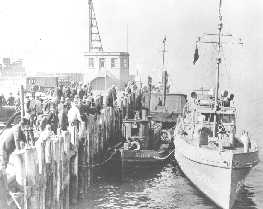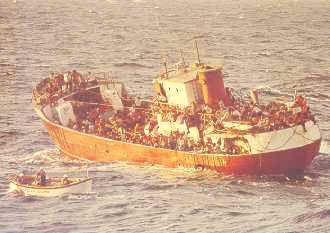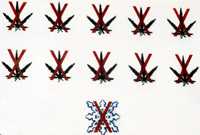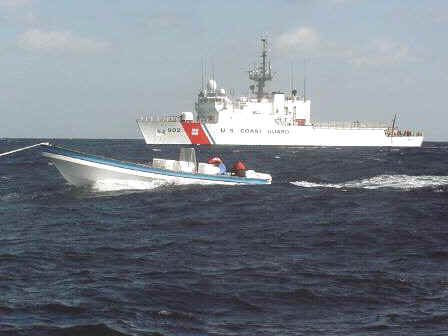United States Coast Guard 2 (3/7)
Law Enforcement
Throughout its history, the Coast Guard's law enforcement responsibilities have primarily been threefold. First, is to ensure that the tariffs are not avoided. Second, to protect shipping from pirates and any other unlawful interdiction. Third, to intercept material and human contraband.

Today tariffs hardly seem controversial. But for the first Congress under the Constitution (1789), the imposition of these taxes was a bold act since such taxes had been a primary catalyst for the War of Independence. The young government's need for money was urgent. Trade revenue had to be the lifeblood of the treasury if the new nation was to survive. During colonial days and the War of Independence, smuggling had been a patriotic duty of maritime America. Seamen were admired who circumvented King George's trade laws, and later outran his fleet during the war. In 1789, a new respect for tariffs was needed.
Congress, guided by Secretary of the Treasury Alexander Hamilton, created a fleet of ten cutters whose responsibilities would be the enforcement of the tariff laws. The spirit of the maritime service was captured in Hamilton's insistence upon thrift and responsibility to the public. Hamilton's creation collected money and did not spend it. Seven of the ten cutters were built for the allotted $1,000 each. Two New England cutters exceeded the amount. Due to the severity of the winters, these vessels had to be larger than their southern sisters, Hamilton appreciated the unique problem, but insisted that the boats "be confined to the smallest dimensions...consistent with safety on ... [the Massachusetts] coast however eligible a larger one might be." the third cutter to exceed appropriations was the cutter built for Philadelphia. Costs exceeded the $1,000 figure by $500. Where the extra money came from is unclear, but it didn't come from Secretary Hamilton or the public treasury. The port revenue collector and the citizens of Philadelphia probably paid for the cost overrun. During the cutters' first ten years of service, the imports and exports of the nation rose from $52 million to $205 million. Along with financial responsibility, Hamilton demanded that the officers be servants of the people. "They [the officers] will always keep in mind that their Countrymen are Freemen & as such are impatient of everything that bears that least mark of a domineering Spirit."

National tariffs did not go unchallenged. In 1832, South Carolina tried to nullify these laws. President Andrew Jackson ordered five cutters to Charleston Harbor "to take possession of any vessels arriving from a foreign port, and defend her against any attempts to dispossess the Customs Officers of her custody." He added, "if a single drop of blood shall be shed there in opposition to the laws of the United States, I will hang the first man I can lay my hands on, upon the first tree I can reach."
Protecting commerce also meant suppressing piracy, still a trade practiced well into the 19th Century. In 1819 the cutters Alabama and Louisiana engaged and captured Bravo, commanded by Jean LaFarge, a lieutenant of the notorious Jean Lafitte of New Orleans. These same two cutters destroyed the pirate stronghold of Patterson's Town on Breton Island. In 1822, Louisiana, cooperating with the Royal Navy and US Navy, swept the Caribbean, capturing five pirate vessels.
Intercepting contraband has been the Coast Guard's most controversial commerce protection responsibility. Slavery was the tumultuous social issue of the first half of the 19th century. In 1794 cutters were charged with preventing the introduction of new slaves from Africa. By the Civil War, cutters captured numerous slavers and freed almost 500 slaves. President Thomas Jefferson declared an unpopular embargo of imports in 1808 and cutters closed all the nation's ports.
The first recorded narcotics seizure by a cutter occurred on 31 August 1890 when the USRC Wolcott, stationed in the Straits of Juan de Fuca, boarded and discovered a quantity of undeclared opium on the U.S. flagged steamer George E. Starr. The cutter seized both the vessel and the opium for violations of Customs laws.
Prohibition in the 1920s made the United States a "dry" nation; Coast Guard cutters conducted the unpopular "Rum War at Sea." During the early days of Prohibition, the Coast Guard was seriously handicapped by the lack of vessels, particularly fast ones. By 1924, "Rum Rows" not only graced New York's doorsteps, but fleets of rum-running craft from broken-down fisherman to freighters of considerable tonnage, hovered off the coasts of the United States, more or less, permanently.

Right: a Coast Guard patrol boat returns to port with vessels seized for violation of the Volstead Act, circa 1927
On 20 March 1929 I'm Alone, of Canadian registry, was anchored off the coast of New Orleans with 2,800 cases of liquor on board. When the cutter Wolcott came into sight, I'm Alone moved seaward. Wolcott asked the Canadian to heave to, so that she could be boarded and examined. I'm Alone refused. Wolcott fired several shells from her single three-pounder across the Canadian's bow. Then the Wolcott's gun jammed and she called for assistance. The cutters Dexter and Dallas responded. That evening I'm Alone hove to. An unarmed officer from Wolcott was allowed to come on board, but the Canadian skipper refused to permit any search. The officer returned to his cutter and the pursuit continued.
The next day, Dexter and Dallas joined in the pursuit. Dexter ordered the Canadian to "Heave to or I shall fire at you." the skipper of I'm Alone refused on the grounds that he was then on the high seas 14 or 15 miles from land or well beyond the legal limit of 12 miles. I'm Alone was sunk at Latitude 25 degrees, 45 minutes West by gunfire from the cutters, interrupted by repeated demands to "heave to." All but one member of the crew was rescued. The commander of the Wolcott insisted that I'm Alone was but 10.8 miles from the coast by his calculations. The Canadian government sent a strongly worded protest to Washington and the controversy dragged through years of legal and diplomatic bickering, finally being settled by arbitration. Such unpopular actions resulted in many instances of negative press, leading one editor to write "Who's Watching the Coast Guard While the Coast Guard's Watching the Coast?"

Right: the Coast Guard Destroyer Tucker, flagship of the Coast Guard's New London Destroyer Force. The Navy transferred a number of its "mothballed" destroyers to the Coast Guard during the enforcement of Prohibition. Tucker was originally commissioned by the Navy in 1916, she was transferred to the Coast Guard in 1926 and served until 1933.
In another celebrated case, the CG-249 overtook a motorboat off the Florida coast. The two men on board had 20 cases of whisky. A young Coast Guardsman and a member of the U.S. Secret Service were killed in a melee that ensued. One of the two rumrunners turned state's evidence and was sentenced to a year and a day in prison. The other was hanged at the Coast Guard Base at Fort Lauderdale, Florida after the Supreme Court refused to review the case.
Having taken on board no less than half a million dollars worth of liquor at St. Pierre Island, Holewood ran down the coast to a point off New York where her crew proceeded to camouflage her to look like a well-known American coaster, Texas Ranger. Disguised, she steamed up the Narrows and was reported as the latter vessel by marine observers. A careful Coast Guard officer, however, detected the fraud. He consulted a shipping news bulletin that reported the Texas Ranger was in the Gulf of Mexico that day. The pseudo- Texas Ranger was overtaken near Haverstraw, her captain and crew attempting to escape in a ship's boat. A search revealed the $500,000 of choice liquors, the Coast Guard's largest single catch.
When the profit was taken from liquor running by the repeal of prohibition (5 December 1933), smuggling declined but did not cease. Several small boats in the Gulf of Mexico continued to run guns to Central American countries and return with narcotics before World War II. It was estimated that 80 to 90 percent of the narcotics smuggled into the United States by 1937 were brought in from Asia. The dropping of narcotics in waterproof containers by incoming vessels became so widespread that Coast Guard patrol boats were assigned to meet these ships far out at sea and trail them right in to their docks.
Intercepting contraband had been the Coast Guard's prime mission prior to World War II. This responsibility had been magnified by Prohibition, (1920-1933), and later in that decade by the prelude of World War II. Following the war, the Coast Guard's prime responsibility shifted largely to safety at sea and aiding navigation.
In the early 1960s, law enforcement once again assumed increased significance. In 1959, Fidel Castro took power in Cuba and within two years, the Coast Guard established patrols to aid refugees and to enforce neutrality, interdicting the transportation of men and arms. This responsibility peaked in 1965 due to increased restrictions on immigration from Cuba and then abated until the Mariel Boatlift of 1980.

Boats with Cuban migrants began departing Mariel, Cuba, in April 1980, (right) after Castro declared the port of Mariel "open." Hundreds of small craft departed Miami and sailed to Mariel, where they loaded up with refugees, in most cases more than the craft was designed to carry safely, and then attempted to return to Miami. What followed became the largest Coast Guard operation ever undertaken in peacetime to that date and is a remarkable example of the Coast Guard's ability to respond to a developing crisis quickly.

Coast Guard resources were sent from all over the Atlantic seaboard to reinforce the taxed Seventh District, and President Jimmy Carter called up 900 reservists to active duty in that District. Coast Guard Auxiliarists also contributed to Coast Guard operations by filling in at various bases, sailing their own vessels and flying their own aircraft to augment the active-duty personnel. The President also ordered Navy assets to assist as well. By the time the boatlift came to an end, over 125,000 Cubans had made the journey to the United States, and of those only 27 perished at sea, a remarkable example of the effectiveness of the men and women in uniform who responded to the crisis with little to no warning beforehand.

During the early 1970s, an old law enforcement job, drug interception, took on increasing emphasis that continues today. From 1963 through 1979, the Coast Guard seized 304 vessels, confiscated over $4 billion in contraband, and made 1,959 arrests. The illegal importation of narcotics continued to grow in the 1980s and 1990s. In an effort to combat this problem the Coast Guard expanded its interdiction efforts. On 9 August 1982, the Department of Defense approved the use of Coast Guard law enforcement detachments onboard US Navy vessels during peacetime. The teams conducted law enforcement boardings from Navy vessels for the first time in U.S. history. In 1995 a Coast Guard LEDET seized the F/V Nataly I when the team discovered 24,325 pounds of cocaine hidden on board, making this the largest U.S. maritime seizure of cocaine to date.

Some of the more noteworthy drug seizures included the following. On 1 November 1984, the cutter Clover nabbed the 63-foot yacht Arrikis 150 miles southwest of San Diego. The yacht was loaded with 13 tons of marijuana and was the largest marijuana bust to date on the West Coast. A few days later, on 4 November, USCGC Northwind became the first icebreaker to make a seizure of narcotics when she captured the P/C Alexi I off Jamaica while carrying 20 tons of marijuana. On 8 May 1987 Coast Guard units, including the cutter Ocracoke, made the largest seizure of cocaine by the Coast Guard to date, 1.9 tons. The Coast Guard expanded its drug-interdiction effort with the largest counter-narcotics operation in Coast Guard history when Operation Frontier Shield commenced on 1 October 1996. On 28 April 2001 a LEDET assigned to the USS Rodney M. Davis, with later assistance from the Active (based in Port Angeles, WA) made the largest cocaine seizure in maritime history when they boarded and seized the Belizean F/V Svesda Maru 1,500 miles south of San Diego. The fishing vessel was carrying 26,931 pounds of cocaine. These are but a few examples of the Coast Guard's continuing effort to combat the flow of illegal drugs into the United States.
